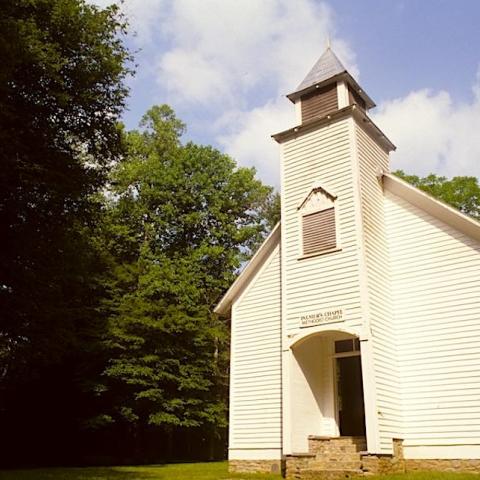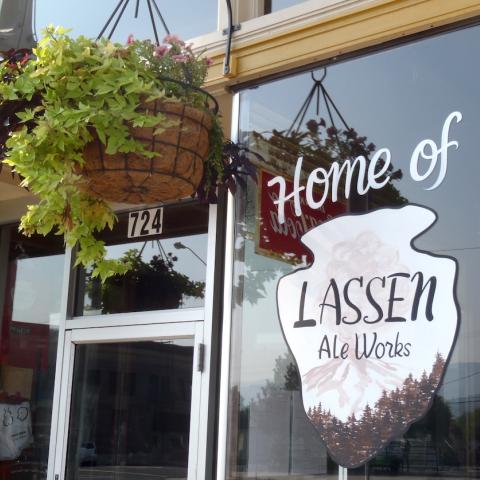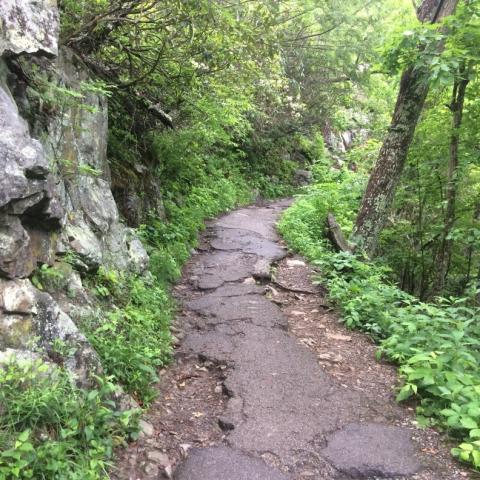
Can a 13-mile-long network of mountain bike trails really enhance your experience in Great Smoky Mountains National Park?/Harold Jerrell file
There is no need for 13 miles of mountain bike trails, with more asphalt and supporting infrastructure, to be cut into an undisturbed section of the Foothills Parkway at Great Smoky Mountains National Park.
At the end of the day, just how would the "experience of riding a narrow roller-coaster with a rhythm of twists and turns" enhance the visitor experience at this wondrous realm of nature? That question spins out of the park's scoping document concerning a "Wears Valley Mountain Bike Trail System." And it's not the only one.
Perhaps the only reason this proposal surfaced is because the area in question was eyed as a "transportation corridor" for the park back in 1944 when Congress told the National Park Service to acquire land on the Tennessee side of Great Smoky for a parkway "to provide an appropriate view of the Park from the Tennessee side of the park, and for other purposes…”
Land indeed was obtained for the envisioned Foothills Parkway, but not all of it was developed. Today, the portion known as Section D remains undeveloped, and its use as a mountain bike park is being considered by the park staff.
In advancing that proposal, the scoping document issued by the park the other day states that "(W)hile more than 800 miles of trails exist in the Park, less than 8 miles are open to biking and there are no by-design mountain biking trails."
However, according to the MTB Project, there are 70 miles of mountain bike routes in or next to the park. True, they might not be single-track miles (many if not all follow gravel roads), but do only single-track trails qualify as mountain bike trails? If so, the surrounding Pisgah, Nantahala, and Cherokee national forests have mountain bike trails.
The park's proposal begs the question of whether there is a need to build 13 miles of mountain bike trails in Great Smoky. Do mountain bike trails that offer riders an "experience of riding a narrow roller-coaster with a rhythm of twists and turns without worry of conflicts with other types of trail users" really improve the cyclist's national park experience? Or do they just give mountain bikers another venue?
Certainly, the proposed trails would make for a fun ride, but would they really improve the experience of visiting Great Smoky? Would the riders be oohing and ahhing at the surrounding parkscape and appreciating the human culture stitched into the park's mountains, hollows, and coves, or be riveted on the "narrow roller-coaster" in front of them so they don't miss a twist or turn?
Then there's the question of paving over the area for two parking lots with 50-80 parking stalls, a mile-long access road, restrooms, picnic area, possible concessions, etc. How large of a footprint would that make in addition to the impacts of building 13 miles of trail? Is that the best use of the landscape? How will that affect flora and fauna?
If this proposal moves forward and the trails and infrastructure are put in, should other parks that don't have mountain bike trails (Shenandoah, Saguaro, Grand Canyon, for example) but which have space, build trails?
Yellowstone National Park found space for a new parking area (which will be erased beginning this fall), so perhaps land in that park could be found for a mountain bike park. Would it enhance the park experience?
Acadia has carriage roads that mountain bikes can traverse, but they certainly don't provide that "experience of riding a narrow roller-coaster with a rhythm of twists and turns..." So should Acadia find room for that experience?
What about other forms of recreation? Tennis courts? Swimming pools? Skateboard parks? Should space be made available for them? Should parks pave trails parallel to roads for road bikes (Grand Teton has) so cyclists and vehicles don't collide?
Not to be overlooked is the cost of such an endeavor. As of FY18 (most recent figures available), Great Smoky's trail system had maintenance needs to the sum of $16.3 million, and of that $13.2 million were deemed "critical" deferred maintenance. With that in mind, is this project affordable?
It's certainly not a proposal without consequences, and not one that is needed.




 Support Essential Coverage of Essential Places
Support Essential Coverage of Essential Places







Comments
Let's not look at the addition of mountain bike trails as an additional attraction aa it has been put. The riders who would use these trails are the same ones camping, hiking or kayaking in the park already. Sure there will be some people passing through to only ride the trails but is that such a bad thing? Mountain bike riders are some of the most kind and friendly people who are far more conservation minded than the average National Park visitor. Not to mention they will be the first to pick up a shovel to help build and maintain these trails. Granted, the surrounding areas are quite built up, touristy and kitschy proper MTB trails can be very minimalist, natural and incredibly sustainable. The thought and care that goes into planning and executing a trail system of any size first and foremost takes into consideration the impact it has on the land it occupies. If the local ride organizations are contacted for volunteers the cost can also be minimized and can also lend to creative and challenging lines for all experience levels of riders.
For the record, Shenandoah Nat'l Park has trails per MTBproject.com
Kudos, excellent points
As I understand it, a recreational use for this land was sought that would not interfere with the subsequent creation of additional Foothills Parkway development. Mountain biking fit this concept, and was a recreational use that did not exist in the park and also was not really available close by, to the extent envisioned. It is important to note that this would not be built in the main park itself, but in land separate from the main park, but owned by the park. It is also a miniscule amount of acreage compared to the vastness of the park. Therefore, it will not in any way detract from any current visitor's experience in the park itself, and might introduce new visitors to the beauty of the Smokies, visitors that like to experience nature in a different way than is currently available. It would certainly be less objectionable than the long line of cars that choke off Cades Cove Loop Road regularly. It is also hard to argue that the trails and users would be any more damaging to the land than the horses who damage many trails that are also used by hikers on a regular basis in the main park. It makes no sense to allow horse back riding in the park on some hiking trails but prohibit mountain bike specific trails on other property owned by the park but outside the main park, if your concern is damage to trails used by hikers. I don't have a problem with some trails in the park being used by horses, but the trucks and trailers take up lots of space in trailhead parking areas, leave trails rutted and eroded, with lots of horse manure to step over. That's not exactly the experience of oohing and ahhing at the surrounding parkscape that the author was speaking of. As was pointed out by someone else, the mountain bike community in Knoxville, which I am not a member of, have been builders of multi-use trails of benefit to hikers, dog walkers, trail runners, bird watchers, etc, and not just mountain bikers. They put their own sweat equity and money into building trails that benefit all, and do tremendous work to help maintain them, for every users' benefit. Maybe if mountain bike trails are built, a similar local mountain bike community could be recruited to help maintain them, lessening the burden on the park service, and increasing the trails' ability to be cared for, used and enjoyed, even if primarily or only by mountain bikers. Most hikers and certainly horse back riders don't do much to help maintain the trails they use in the main park. This proposal deserves to be considered with an open mind, especially in view of how the park is available to plenty of other users who already use the park in ways that not everyone else shares. Campgrounds and picnic areas exist even though not every park visitor camps or picnics in them. I don't think that this proposal, if enacted, will have any negative impact on anyone using the main park for uses already permitted. To object to it because you don't mountain bike and wouldn't benefit from it (and I am not a mountain biker), seems pretty selfish.
Not to nbe missed here isn that the NPS is broke and in future years this trail will add to the defered maintance. Lets just take care of what we currently have.
Unfortunately bikers, equestrians, hikers all want the trails to themselves and oppose other users of the area. It is great that groups are trying to protect lands but it would be better if everyone worked together. In my experience hikers don't want bikers on "their" trails. That is the real problem. Bike groups maintain trails and care about the environment just as much as hikers. It is important to understand the motivation behind limiting mountain bikers in the area. If development is limited than coexist peacefully with mountain bikers. If that isn't an option don't oppose development of mountain bike trails. If neither are acceptable it is very clear you don't like mountain bikers. The parks were not created for you. "forever wild. For the people".
You sir obviously have never ridden deep into the woods on a bike set up for that very adventure. It's a Mystical experience.Zip and weave....yes we do. Do we wreck heavens yes and we get up and do it again. As for wrecking trails your sadly mistaken. Were not only riders we are builders. Not only Mt. bike trails but also multi purpose trails, rails to trails and in some cases helping to enhance green ways. We volunteer our time to do trail maitance, trail planning and building.So please be sure of what you speak lest you are deemed uninformed.
Ride into wonderland:)
David
This author is clearly so detached from reality that I doubt he even knows who's president. MTB trails can easily be built with hand tools in a non-invasive fashion (Pisgah, Dupont) and attract people who actually enjoy and respect nature, unlike the everyday tourists who don't clean up after themselves. In addition, all trail builders take into consideration erosion, drainage, environmental impact and work to improve the area if anything.
You might be correct today ZB, but just a few years back Forest Service officials on the Pisgah were thinking of charging for trail use due to damage.
https://www.citizen-times.com/story/news/local/2017/12/09/should-people-...
More recently, even bike clubs realize the damage that's been done on occasion.
https://crankjoy.com/dont-ride-during-freeze-thaw/
That said, kudos to the clubs that raise money for trail maintenance and get their members out to put their muscles to work on it.